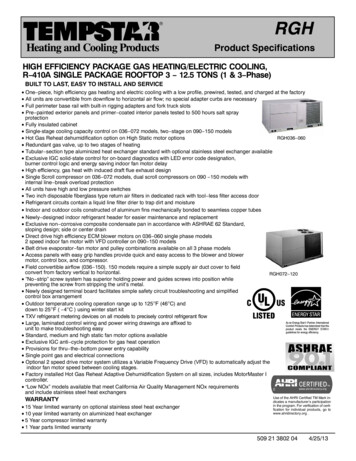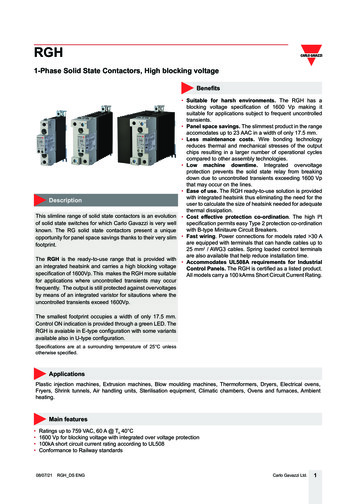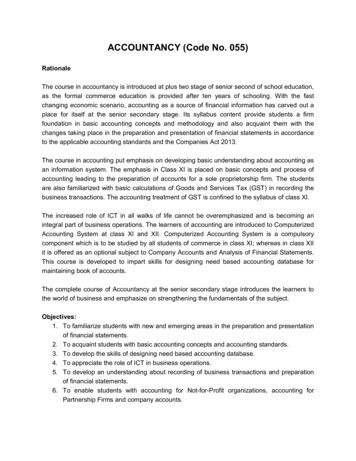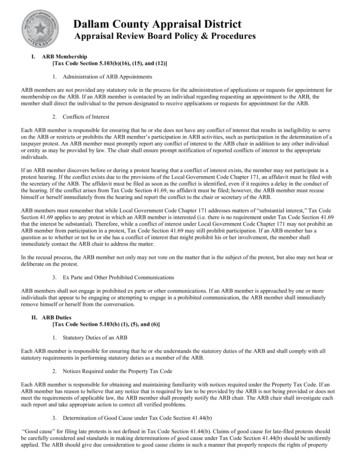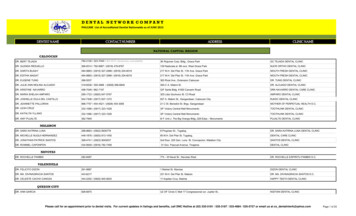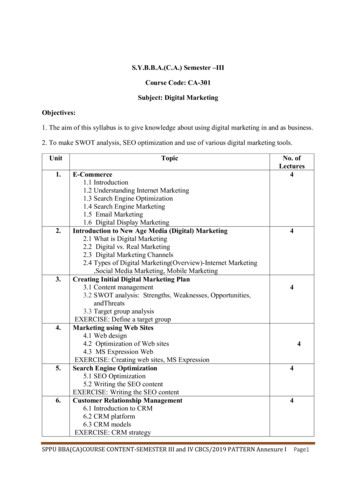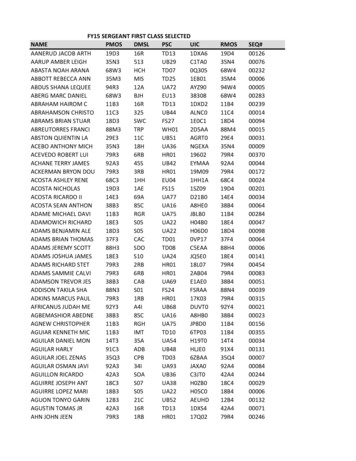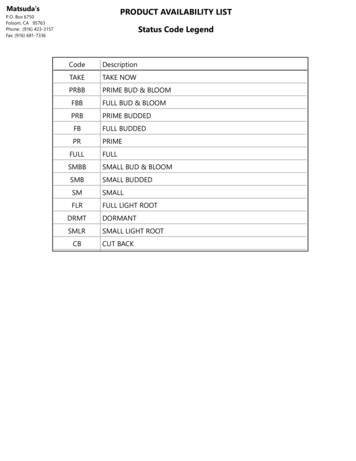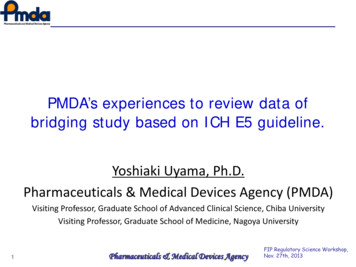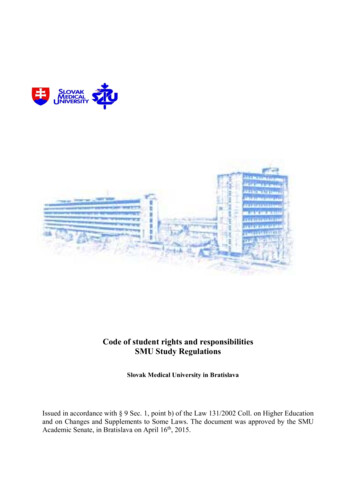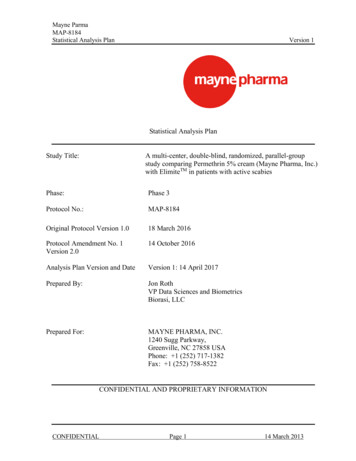
Transcription
NCT02670538Study ID: RGH‐MD‐53Title: A Phase 3, Randomized, Double‐Blind, Placebo‐Controlled, Parallel‐Group, Multicenter, Fixed‐Dose Clinical Trial Evaluating the Efficacy, Safety and Tolerability of Cariprazine in Patients with Bipolar IDepressionStatistical Analysis Plan Amendment #1 Date: 08‐Mar‐2018
Allergan ConfidentialCariprazineRGH-MD-53 Amended SAP #11.Title PageSTATISTICAL ANALYSIS PLANA Phase 3, Randomized, Double-Blind, Placebo-Controlled, Parallel-Group, Multicenter,Fixed-Dose Clinical Trial Evaluating the Efficacy, Safety and Tolerability of Cariprazine inPatients with Bipolar I DepressionOriginal SAP Date: 2017-03-31Amendment #1 Date: 2018-03-08Protocol Number:Development Phase:Product Name:Study Statistician:Sponsor:RGH-MD-533CariprazineAllergan Sales, LLCThis document is the property of Allergan Sales, LLC, and may not, in full or part, be passed on,reproduced, published, distributed to any person, or submitted to any regulatory authoritywithout the express written permission of Allergan Sales, LLC.Page 1 of 49
Allergan ConfidentialCariprazineRGH-MD-53 Amended SAP #12.Table of Contents1.Title Page . 12.Table of Contents . 22.1List of Tables . 32.2List of Figures . 53.List of Abbreviations and Definition of Terms . 64.Introduction. 75.4.1Study Design Summary . 74.2Study Objectives and Endpoints . 84.3Schedule of Evaluations . 13Statistical Methodology and Study Endpoints . 155.1Statistical Methods Planned in the Protocol and Determination of Sample Size . 155.1.15.2Statistical and Analytical Plans . 155.1.1.1 Common Conventions . 155.1.1.2 Demographics. 195.1.1.3 Efficacy and Pharmacokinetic Analyses . 225.1.2 Determination of Sample Size . 33Changes in the Conduct of the Study or Planned Analyses . 335.2.15.2.2Changes in the Conduct of the Study . 33Changes to Analyses Prior to Database Lock . 33Page 2 of 49
Allergan ConfidentialCariprazineRGH-MD-53 Amended SAP #17.References. 492.1List of TablesTable 3-1Abbreviations and Definitions of Terms . 6Table 4-2Montgomery-Åsberg Depression Rating Scale (MADRS). 10Table 4-3Clinical Global Impressions–Severity (CGI-S) . 10Page 3 of 49
Allergan ConfidentialCariprazineRGH-MD-53 Amended SAP #1Table 5-1Analysis Populations. 15Table 5-2Statistical Methodology . 16Table 5-4Analysis Population Summaries . 19Table 5-5Participant Disposition Summaries. 19Table 5-6Protocol Deviation Summary. 20Table 5-7Demographic and Baseline Characteristics Summaries . 20Table 5-8Demographic and Baseline Characteristics Summaries . 20Table 5-9Medical History Summary . 21Table 5-10Medication Summaries . 21Table 5-11Efficacy Assessments . 22Table 5-12Efficacy Endpoint Baseline Definitions. 23Table 5-13Efficacy Analyses. 23Table 5-15Study Treatment Summaries . 26Table 5-16AE Terms . 26Table 5-17AE Summaries . 27Page 4 of 49
Allergan ConfidentialCariprazineRGH-MD-53 Amended SAP #1Table 6-6AE of Special Interest Terms: Ocular Events . 412.2List of FiguresPage 5 of 49
Allergan ConfidentialCariprazineRGH-MD-53 Amended SAP #13.List of Abbreviations and Definition of TermsTable 3-1Abbreviations and Definitions of -SSRSeCRFECGETHAMD-17HAM-AITTDefinitionadverse eventAbnormal Involuntary Movement Scaleanalysis of covarianceAnatomical Therapeutic ChemicalBarnes Akathisia Rating Scalechange from baselineClinical Global Impressions–SeverityColumbia–Suicide Severity Rating Scaleelectronic case report formelectrocardiogram, electrocardiographicearly termination17-item Hamilton Depression Rating ScaleHamilton Anxiety Rating t squaresMontgomery-Åsberg Depression Rating ScaleMedication Dictionary for Regulatory ActivitiesMini International Neuropsychiatric Interviewmixed-effects model for repeated measurespotentially clinically significantpharmacokineticparticipant identificationpreferred termQuick Inventory of Depressive Symptomatology – Self-ReportQT interval corrected for heart rateQT interval corrected for heart rate using the Bazett formula (QTcB QT/(RR)½)QT interval corrected for heart rate using the Fridericia formula (QTcF QT/(RR)⅓)serious adverse eventstatistical analysis planSimpson-Angus ScaleLe Système International d’Unités (International System of Units)system organ classtreatment-emergent adverse eventWorld Health OrganizationYoung Mania Rating ScalePage 6 of 49
Allergan ConfidentialCariprazineRGH-MD-53 Amended SAP #14.IntroductionThis statistical analysis plan (SAP) details comprehensive, technical specifications of thestatistical analyses of the efficacy and safety data outlined and/or specified in the final protocolof Study RGH-MD-53 and the most recent amendment (version #2). Specifications of tables,figures, and data listings are contained in a separate document.This document is organized into 3 main sections:1. Study overview2. Statistical Methodology and Study Endpoints3. Data Handling and Analysis Conventions4.1Study Design SummaryMethodology:Multicenter, randomized, double-blind, placebo-controlled, parallel-group, fixed-dose studyNumber of Patients:480 planned (approximately 160 per treatment group)Diagnosis and Main Criteria for Inclusion:Male and female outpatients who are 18 to 65 years of age, meet Diagnostic and StatisticalManual of Mental Disorders, Fifth Edition (DSM-5) criteria for bipolar I disorder withoutpsychotic features confirmed by the administration of the Mini Internationa l NeuropsychiatricInterview (MINI), with a current major depressive episode of at least 4 weeks and not exceeding12 months in duration, a minimum score of 20 on the 17-item Hamilton Depression Rating Scale(HAMD-17), a minimum score of 2 on item 1 of the HAMD-17, and a minimum score of 4 onthe Clinical Global Impressions-Severity Scale (CGI-S) at Visits 1 and 2.Test Product, Dosage, and Mode of Administration:Cariprazine 1.5 mg/day and 3.0 mg/day capsules, oral administrationDuration of Treatment:A no-drug screening period of approximately 7-14 days, followed by 6 weeks of double-blindtreatment and a 1-week, no investigational product safety follow-up period.Page 7 of 49
Allergan ConfidentialCariprazineRGH-MD-53 Amended SAP #1Reference Therapy, Dosage, and Mode of Administration:Matching placebo capsules, oral administration4.2Study Objectives and EndpointsEach study objective is presented with corresponding endpoint(s) below:Table 4-1Study Objectives and EndpointsObjectives To evaluate the efficacy of cariprazine 1.5 mg/dayand 3.0 mg/day relative to placebo in patients withbipolar I depressionEndpointsPrimary Efficacy EndpointChange from baseline to Week 6 in MontgomeryÅsberg Depression Rating Scale (MADRS) totalscoreSecondary Efficacy Endpoint Change from baseline to Week 6 in Clinical GlobalImpressions-Severity Scale (CGI-S)Page 8 of 49
Allergan ConfidentialCariprazineRGH-MD-53 Amended SAP #1ObjectivesEndpointsPage 9 of 49
Allergan ConfidentialCariprazineRGH-MD-53 Amended SAP #1Table 4-2Montgomery-Åsberg Depression Rating Scale (MADRS)Item ListaScore Range1 Apparent sadness(Each item is rated on a scale from 0 to 6.)2 Reported sadness3 Inner tension4 Reduced sleep5 Reduced appetite6 Concentration difficulties7 Lassitude8 Inability to feel9 Pessimistic thoughts10 Suicidal thoughtsaScale for each item described in Appendix IV of theprotocol.Table 4-3Clinical Global Impressions–Severity (CGI-S)GradeDescription1Normal, not at all ill2Borderline ill3Mildly ill4Moderately ill5Markedly ill6Severely ill7Among the most extremely ill patientsPage 10 of 49
Allergan ConfidentialCariprazineRGH-MD-53 Amended SAP #1Page 11 of 49
Allergan ConfidentialCariprazineRGH-MD-53 Amended SAP #1Page 12 of 49
Allergan ConfidentialCariprazineRGH-MD-53 Amended SAP #1Page 13 of 49
Allergan ConfidentialCariprazineRGH-MD-53 Amended SAP #1Page 14 of 49
Allergan ConfidentialCariprazineRGH-MD-53 Amended SAP #15.Statistical Methodology and Study Endpoints5.1Statistical Methods Planned in the Protocol and Determination ofSample SizeThis statistical analysis plan (SAP) will be approved prior to database lock. The SAP expands thestatistical section of the protocol and contains a detailed description of methods to analyze datacollected in the study. The text portion of the SAP will be included in the CSR report asAppendix 16.1.9.5.1.1Statistical and Analytical PlansStatistical analyses will be conducted using SAS Version 9.3 or newer.5.1.1.1Common Conventions5.1.1.1.1Analysis PopulationsThe analysis populations will consist of participants as defined below:Table at (ITT)5.1.1.1.2Analysis PopulationsDefinitionAll patients who signed informed consent and received a PIDnumberAll patients in the Screened Population who were randomized toa treatment group in the study.All patients in the Randomized Population who took at least 1dose of double-blind investigational productAll patients in the Safety Population who had at least 1postbaseline assessment of the MADRS total score.Study Treatment—Randomized assignmentRandomized assignmentRandomized assignmentStudy TreatmentsThe following treatment groups are defined for this study: Cariprazine 1.5 mg/day Cariprazine 3.0 mg/day Placebo5.1.1.1.3Statistical MethodologyThe methodologies defined below apply as specified to individual endpoints defined in this SAP.When indicated, 95% two-sided confidence intervals and two-sided p-values will be presented.Page 15 of 49
Allergan ConfidentialCariprazineRGH-MD-53 Amended SAP #1Individual endpoint analyses may specify exceptions (additions or deletions) to these generaldefinitions.Table 5-2Statistical MethodologyMethodologyCategorical counts Categoricaldescriptives PCS descriptives Shift analysis DescriptionNumber of participants in individual categorieso Participants with 1 qualifying event counted once per individual categoryNumber and percentage of participants in individual categorieso Participants with 1 qualifying event counted once per individual categoryo N1 number of patients with non-missing baselineo For AE summary of sex-specific AEs, the percentage is based on thenumber of participants of the sexNumber and percentage of participants meeting potentially clinically significant(PCS) criteriao Participants with 1 qualifying event counted once per PCS categoryPercentage denominator number of participants with non-missing baseline and 1 non-missing postbaseline assessmento Unevaluable assessments considered missingN1 participants with non-missing values at both baseline and the specifiedpostbaseline analysis visitNumber and percentage of participants in individual baseline and postbaselinecategoriesPercentage denominator number of participants in individual baseline categoriesN1 participants with non-missing values at both baseline and the specifiedpostbaseline analysis visitN, mean, standard deviation (SD), median, minimum, maximumContinuousdescriptivesCFB descriptives Continuous descriptives for baseline, postbaseline, and change from baseline (CFB)valuesCFB MMRM Continuous descriptives and SE for baseline, postbaseline, and CFB values at eachanalysis visitEstimates derived from mixed model for CFB value controlling for fixed factors(treatment group, pooled study center, and visit), covariates (baseline value), andinteractions (treatment group by visit, baseline value by visit), with an unstructuredcovariance matrix. If the model fails to converge based on the unstructuredcovariance matrix, then structures of Heterogenous Toeplitz, Toeplitz, andCompound Symmetry will be applied, in the specified order, until the modelconverges. The Kenward-Roger approximation will be used to estimate denominatordegrees of freedom.o LS means and standard errorso LS mean differences, standard errors, and for comparisons of Cariprazine1.5 mg/day and Cariprazine 3.0 mg/day vs Placebo Page 16 of 49
Allergan ConfidentialCariprazineRGH-MD-53 Amended SAP #1MethodologyoDescriptionP-values from contrast t-test comparing Cariprazine 1.5 mg/day andCariprazine 3.0 mg/day vs Placebo (Note the nominal p-values for primaryand secondary endpoints will be adjusted through the matched parallelgatekeeping procedure, as described in Section 5.1.1.3.2.)CFB change from baseline; ANCOVA analysis of covariance; MMRM mixed model for repeated measures;Raw and derived data listings will be provided, and will be fully defined in the table, figure, anddata listing specification document.Page 17 of 49
Allergan ConfidentialCariprazineRGH-MD-53 Amended SAP #15.1.1.1.5Site PoolingFor efficacy analyses in which study center is a factor, a small center will be defined as a centerwith fewer than 2 patients in at least 1 treatment group in the ITT Population. Small centers willbe pooled to form pseudo-centers so that each treatment group includes at least 2 ITT patientswithin the center. Pooling will be done within each country using the following algorithm:1. Based on the number of ITT patients, small centers will be ordered from the largest to thesmallest, and centers of the same size will be ordered from the largest center number tothe smallest center number.2. The pooling process starts with the largest small center from the top, which will bepooled with the smallest from the bottom until a non-small center is formed.3. The process will be repeated using the small centers left out after the first pass.Page 18 of 49
Allergan ConfidentialCariprazineRGH-MD-53 Amended SAP #14. If any centers are left out at the end of the process, they will be pooled with the smallestpseudo-center. If there is more than 1 smallest pseudo-center, the pseudo-center with thesmallest center number will be selected. In case that the pseudo center formed by poolingall small centers is still a small center, it will be pooled with the smallest non-smallcenter. If there is more than 1 smallest non-small center, the one with the smallest centernumber will be selected.The pseudo-centers will be used for all efficacy analyses when the model is adjusted for studycenter.5.1.1.2Demographics5.1.1.2.1Analysis PopulationsThe distribution of participants within the analysis populations will be summarized as follows:Table 5-4Analysis Population SummariesPopulationScreened PopulationDescriptionDistribution overall and within StudyCenter in totalDistribution overall and within StudyCenter in total and by treatment groupRandomized, Safety,and ITT l counts—Categorical countsParticipant DispositionParticipant disposition encompasses the distribution of participants who enter, complete, anddiscontinue each specified analysis period, along with eCRF-reported discontinuation reasonsfrom each respective analysis period. Participant disposition will be summarized as follows:Table 5-5Participant Disposition SummariesParameterScreening dispositionDescriptionDistribution in the Screened Populationoverall and within Study Center in totalDistribution in the Randomized, Safetyand ITT Population overall and withinStudy Center in total and by treatmentgroupDistribution by reason in the SafetyPopulation in total and by treatment nTimingScreening PeriodDouble-blindTreatment ldescriptivesDouble-blindTreatment PeriodCategoricaldescriptivesPage 19 of 49
Allergan ConfidentialCariprazineRGH-MD-53 Amended SAP #15.1.1.2.3Protocol DeviationsProtocol deviations will be defined in Protocol Deviation Requirement Specification, includingimportance classification. Protocol deviations will be summarized as follows for theRandomized Population:Table 5-6Protocol Deviation SummaryParameterDescriptionImportant protocolDistribution in the Randomized Populationdeviations1in total and by treatment group1Protocol deviations will be criptivesDemographicsDemographics will be summarized in total and by treatment group for the ITT and SafetyPopulations, as follows:Table 5-7Demographic and Baseline Characteristics SummariesParameterAgeDescriptionAge (years) relative to informed consentdate 20 years 20 to 30 years 30 to 40 years 40 to 50 years 50 to 60 years 60 years eCRF categories Race groupo Whiteo Non-whiteAge groupSex, race, and ethnicity5.1.1.2.5TimingInformed consentInformed consentScreening descriptivesCategoricaldescriptivesBaseline CharacteristicsBaseline characteristics will be summarized in total and by treatment group for the ITT andSafety Populations, as follows:Table 5-8Demographic and Baseline Characteristics SummariesParameterBaseline characteristicsDescription Height (m) Weight (kg) Body mass index (BMI) Weight (kg) / height (m)2Endpoints and timing fully described inSection 5.1.1.3 MADRS CGI-SBaseline efficacy TimingLatest assessment inScreening usdescriptivesSummary for ITT Population onlyPage 20 of 49
Allergan ConfidentialCariprazineRGH-MD-53 Amended SAP #15.1.1.2.6Medical HistoryMedical history, encompassing abnormalities and surgeries reported as occurring before theScreening Visit, will be coded using the Medical Dictionary for Regulatory Activities(MedDRA), version 19.1 or newer. Unique participants who report medical history events will besummarized by MedDRA system organ class (SOC) and preferred term (PT) in total and bytreatment group for the Safety Population as follows:Table 5-9Medical History SummaryParameterMedical and SurgicalhistoryBipolar HistoryDescriptionAbnormalities and surgeries occurringbefore the Screening VisitBipolar disorder history occurring beforethe Screening VisitOther psychiatric history occurring beforethe Screening VisitTimingScreening PeriodNon-drug psychiatric treatments takenbefore the Screening VisitAbnormalities of ocular events occurringbefore the Screening VisitScreening PeriodOphthalmic medical and surgical historyoccurring before the Screening VisitScreening PeriodOther PsychiatricDisorder MedicalHistoryNon-Drug PsychiatricTreatment HistoryHistory of OcularEvents of SpecialInterestOphthalmic Medicaland Surgical HistoryScreening PeriodScreening PeriodScreening PeriodSOCs will be sorted alphabetically; PTs will be sorted in descending frequency in the highest dose aldescriptivesPrior and Concomitant MedicationsMedications will be coded using the World Health Organization (WHO) Drug Dictionary,version WHODRUG DDE HD 3Q2016 or newer. Unique participants who reportedmedications will be summarized by Anatomical Therapeutic Chemical (ATC) 4 class and PT intotal and by treatment group for the Safety Population as described in the table below.Additionally, the Concomitant Rescue Medications will be summarized, for each medication,with the mean daily dose, in total and by treatment group for the Safety Population.Table 5-10ParameterPrior medications1Concomitant medications1Concomitant Medicationof Interest- Summary ofRescue Medication MeanDaily Dose1Medication SummariesDescriptionMedication taken before the date of thefirst dose of double-blind investigationalproduct.Medication taken on or after the date of thefirst dose of double-blind investigationalproduct.Rescue Medication taken on or after thedate of the first dose of double-blindinvestigationalproduct.TimingScreening ndTreatment PeriodCategoricaldescriptivesDouble-blindTreatment PeriodContinuousdescriptivesATC4 classes will be sorted alphabetically; PTs will be sorted in descending frequency in the highest dose group.1Participant data will be listed.Page 21 of 49
Allergan ConfidentialCariprazineRGH-MD-53 Amended SAP #15.1.1.3Efficacy and Pharmacokinetic AnalysesEfficacy analyses will be based on the ITT Population. Pharmacokinetic endpoints and analyseswill not be described in this SAP.The following efficacy assessments and terms are defined:Table 5-11Assessment/TermMontgomery-ÅsbergDepression RatingScale (MADRS)Clinical GlobalImpressions–Severity (CGI-S)Efficacy AssessmentsDescription10-Item, clinician-rated scale to evaluate the patient’s depressive symptomatology. Eachitem is scored on a 7-point scale, from 0 to 6 with a score of 0 reflecting no symptoms and ascore of 6 reflecting symptoms of maximum severity.The MADRS total score is the sum of the 10 items from the MADRS at each visit if noitem has missing score. If the number of missing items at a visit is 2 or less, the MADRStotal score will be calculated as (sum of nonmissing items) (total number of items) /(number of nonmissing items). If more than 2 items of the MADRS are missing, then thetotal score will be set to missing.Clinician-rated scale that measures the overall severity of a patient’s illness in comparisonwith the severity of other patients the physician has observed. The patient is rated on a scalefrom 1 to 7 with 1 indicating a “normal state”and 7 indicating “among the most extremely ill patients.”.Page 22 of 49
Allergan ConfidentialCariprazineRGH-MD-53 Amended SAP #1Assessment/TermDescriptionBaseline assessments for applicable efficacy endpoints defined as follows:Table 5-12Efficacy Endpoint Baseline DefinitionsEndpointClinical Global Impressions–Severity (CGI-S) and the totalscores of the following:Montgomery-Åsberg DepressionRating Scale (MADRS),5.1.1.3.1DescriptionThe baseline for each specific efficacy endpoint isdefined as the value recorded at Visit 2/Week 0. Ifthis value is not available, the last available valuebefore the first dose of double-blind investigationalproduct will be used as the baseline value.TimingTreatment Day 1.If not available,then the lastavailable valuebefore the firstdose from Day -14to Day 1Efficacy EndpointThe following efficacy variables will be analyzed as described below.Table 5-13Efficacy AnalysesAssessmentMADRSParameterChange from baseline in MADRS totalscore to Week 6CGI-SChange from baseline in CGI-S score byvisitTimingTreatment Period:Week 6MethodologyCFB MMRMTreatment Period:Weeks 1, 2, 4, and 6CFB MMRMPage 23 of 49
Allergan ConfidentialCariprazineRGH-MD-53 Amended SAP tiple Comparisons Procedure for Primary and SecondaryEndpointsProcedure:To control the overall type I error rate for multiple comparisons of 2 active doses versus placeboat Week 6 for the primary and secondary efficacy parameters, the parallel gatekeeping procedurewill be implemented (Chen et al, 2005).Hypotheses:The 4 null hypotheses will be grouped into 2 families denoted by F1 and F2, with F1 consis tingof 2 null hypotheses for comparisons of the 2 active doses versus placebo in change frombaseline to Week 6 in MADRS total score (i.e., F1 {H11, H12}), and F2 consisting of 2 nullhypotheses for comparisons of the 2 active doses versus placebo in change from baseline toWeek 6 in CGI-S score (i.e., F2 {H21, H22}). Family F1 will serve as the parallel gatekeeper forF2.Testing:The matched gatekeeping procedure utilizes the special logical relationship between the primaryand the secondary parameters to enhance the power of statistical testing. The secondary efficacyparameter will be tested at a specific dose only if the corresponding primary efficacy parameteris statistically significant. The Simes test will be used to derive the local p-values for theinteraction hypotheses. The adjusted p-values for the 4 elementary hypotheses will be calculatedPage 24 of 49
Allergan ConfidentialCariprazineRGH-MD-53 Amended SAP #1based on the closed testing principle. Statistical significance will be determined by comparingthe adjusted p-values to α 0.050.Weights for Intersection Tests in the Matched Parallel GatekeepingProcedureIntersection hypothesisH11 H12 H21 H22H11 H12 H21H11 H12 H22H11 H12H11 H21 H22H11 H21H11 H22H11H12 H21 H22H12 H21H12 H22H12H21 000.510H2200000.500.5000000.501Safety AnalysesSafety analyses will be based on the Safety Population.Baseline assessments for applicable safety endpoints defined as follows:5.1.1.4.1Study Treatment Exposure and ComplianceStudy treatment exposure and compliance will be summarized by treatment group for the SafetyPopulation as follows:Page 25 of 49
Allergan ConfidentialCariprazineRGH-MD-53 Amended SAP #1Table 5-15Study Treatment SummariesParameterStudy treatmentexposure (days)Patient-years of studytreatment exposure(years)Study treatmentcompliance (%)DescriptionTreatment end date - treatment start date 1Sum over participants of study treatmentexposure5.1.1.4.2Summary by visit interval and overallNumber of capsules actuallytaken100 Number of capsules expectedto be taken The total number of capsulesactually taken during a specificperiod is calculated as the sum ofthe number of capsules takenduring that interval. The number of capsules expectedto be taken for a specific intervalwill be calculated by multiplyingthe number of days in that periodby the number of capsules to betaken per day.TimingTreatment PeriodTreatment PeriodWeek 0 (Baseline)Week 1 visit (notinclusive), Week 1visit-Week 2 visit(not inclusive),Week 2 visit-Week4 visit (notinclusive), Week 4visit-Week 6 visit(not inclusive), andOverall �ContinuousdescriptivesAdverse EventsThe following adverse event (AE) terms are defined:Table 5-16TermTreatmentemergentNewlyemergentOn-therapyAE TermsDescriptionAn event that initially occurs or increases in severity on or after the treatment start date, where: Treatment start date event start date treatment end date 30An AE occurring during the safety follow-up period will be considered a newly emergent adverseevent if the AE was not present before the start of the safety follow-up period or was presentbefore the start of the safety follow-up period and increased in severity during the safety followup period.An event where: Treatment start date event start date treatment end date 30AEs, encompassing abnormalities and surgeries reported as occurring after the Screening Visit,will be coded using MedDRA version 19.1 or newer. Unique patients reporting AEs in thefollowing AE categories will be summarized by treatment group for the Safety Population asfollows:Page 26 of 49
Allergan ConfidentialCariprazineRGH-MD-53 Amended SAP #1Table 5-17AE SummariesParameterOverall summaryDescriptionOverall summary only for the followingcategories: Deaths Treatment-emergent AEs(TEAEs) On-therapy Serious adverseevents (SAEs) AEs leading to discontinuationOverall summary only for the followingcategories: Deaths Serious adverse eve
RGH-MD-53 Amended SAP #1 Page 1 of 49 1. Title Page STATISTICAL ANALYSIS PLAN A Phase 3, Randomized, Double-Blind, Placebo-Controlled, Parallel-Group, Multicenter, Fixed-Dose Clinical Trial Evaluating the Efficacy, Safety and Tolerability of Cariprazine in Patients with Bipolar I Depression Original SAP Date: 2017-03-31 Amendment #1 Date: 2018 .

